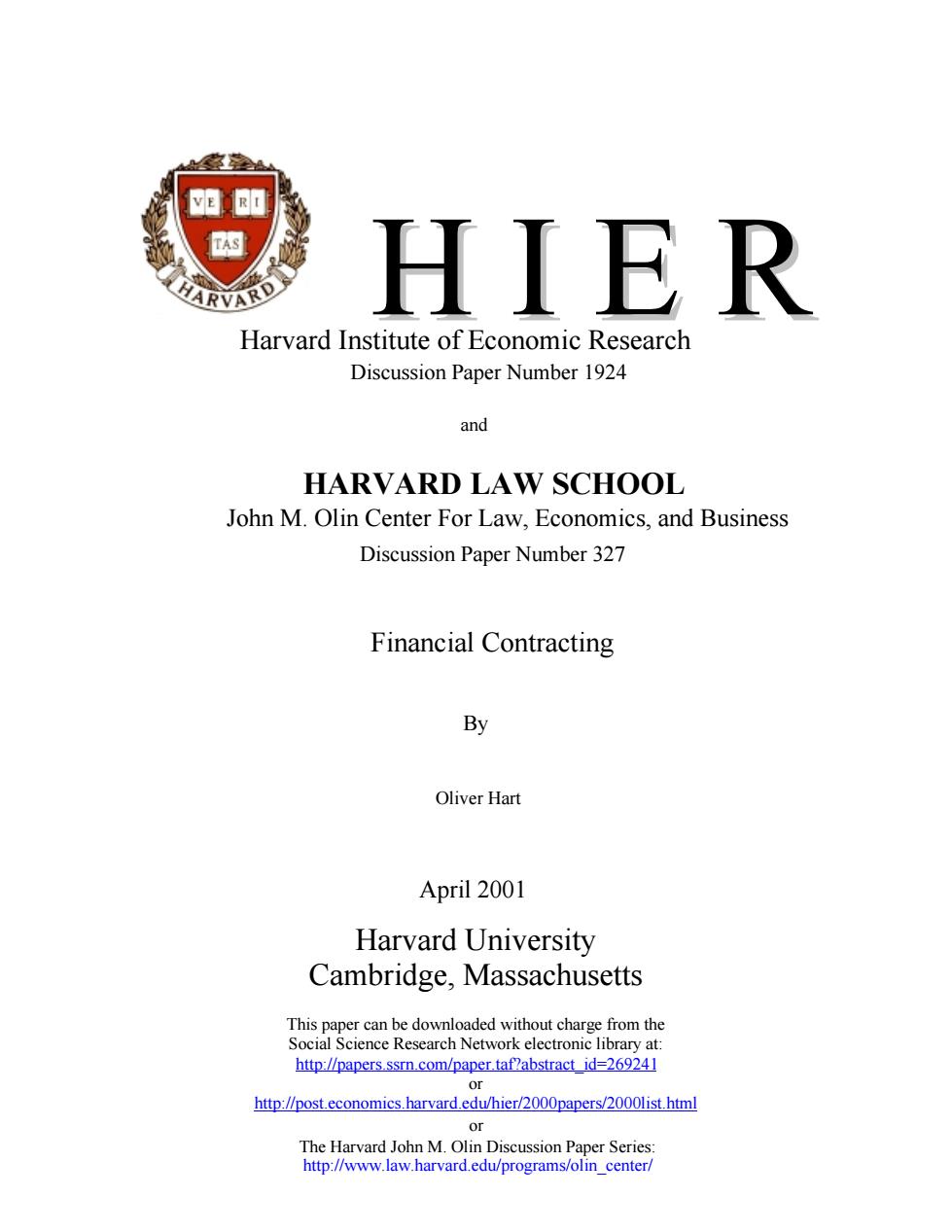
ARVARD HIER Harvard Institute of Economic Research Discussion Paper Number 1924 and HARVARD LAW SCHOOL John M.Olin Center For Law,Economics,and Business Discussion Paper Number 327 Financial Contracting By Oliver Hart April 2001 Harvard University Cambridge,Massachusetts This paper can be downloaded without charge from the Social Science Research Network electronic library at: http://papers.ssrn.com/paper.taf?abstract id=269241 or http://post.economics.harvard.edu/hier/2000papers/2000list.html or The Harvard John M.Olin Discussion Paper Series http://www.law.harvard.edu/programs/olin center/
H I E R By April 2001 Harvard University Cambridge, Massachusetts This paper can be downloaded without charge from the Social Science Research Network electronic library at: http://papers.ssrn.com/paper.taf?abstract_id=269241 or http://post.economics.harvard.edu/hier/2000papers/2000list.html Financial Contracting Oliver Hart Harvard Institute of Economic Research Discussion Paper Number 1924 or http://www.law.harvard.edu/programs/olin_center/ The Harvard John M. Olin Discussion Paper Series: HARVARD LAW SCHOOL John M. Olin Center For Law, Economics, and Business Discussion Paper Number 327 and
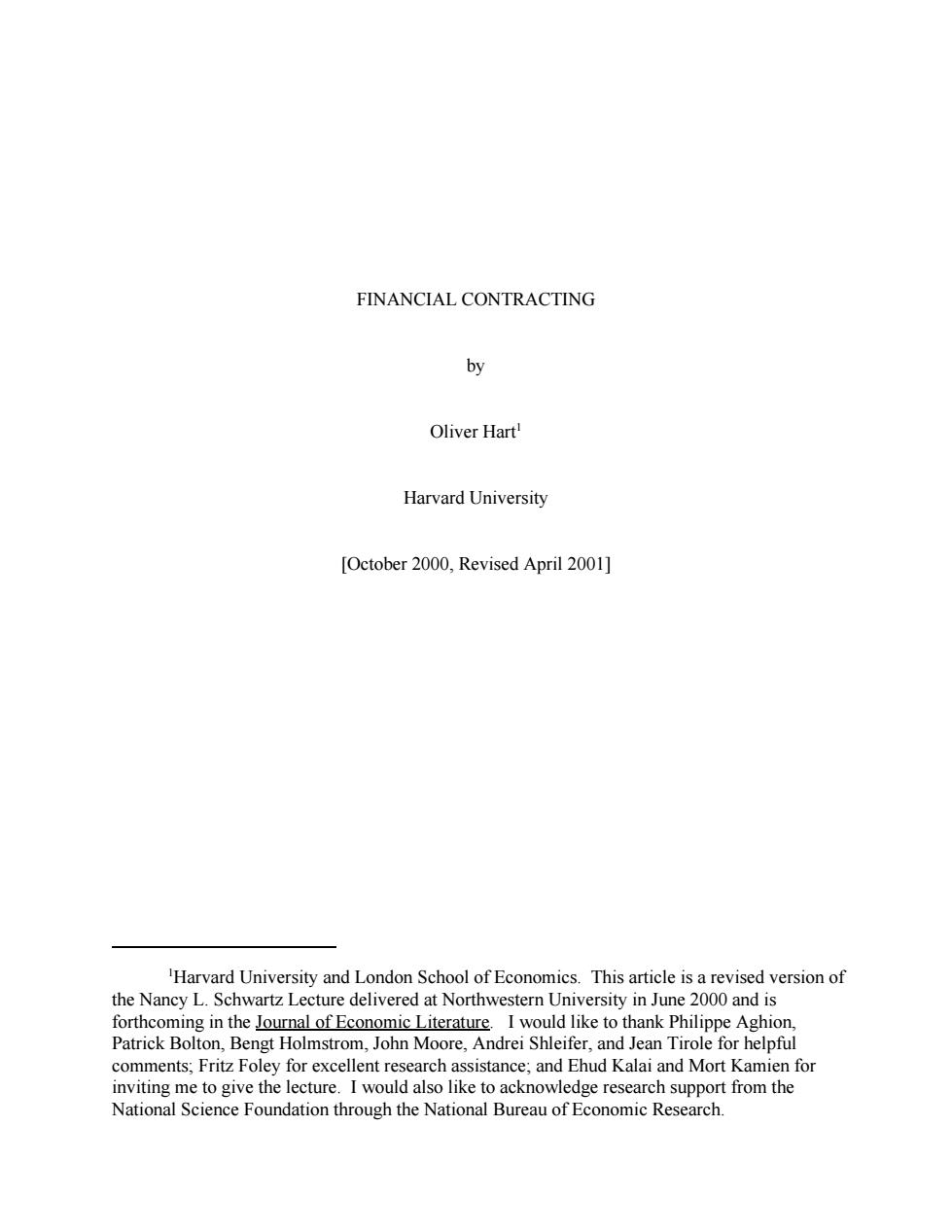
FINANCIAL CONTRACTING by Oliver Hart' Harvard University [October 2000,Revised April 2001] Harvard University and London School of Economics.This article is a revised version of the Nancy L.Schwartz Lecture delivered at Northwestern University in June 2000 and is forthcoming in the Journal of Economic Literature.I would like to thank Philippe Aghion, Patrick Bolton,Bengt Holmstrom,John Moore,Andrei Shleifer,and Jean Tirole for helpful comments;Fritz Foley for excellent research assistance;and Ehud Kalai and Mort Kamien for inviting me to give the lecture.I would also like to acknowledge research support from the National Science Foundation through the National Bureau of Economic Research
1Harvard University and London School of Economics. This article is a revised version of the Nancy L. Schwartz Lecture delivered at Northwestern University in June 2000 and is forthcoming in the Journal of Economic Literature. I would like to thank Philippe Aghion, Patrick Bolton, Bengt Holmstrom, John Moore, Andrei Shleifer, and Jean Tirole for helpful comments; Fritz Foley for excellent research assistance; and Ehud Kalai and Mort Kamien for inviting me to give the lecture. I would also like to acknowledge research support from the National Science Foundation through the National Bureau of Economic Research. FINANCIAL CONTRACTING by Oliver Hart1 Harvard University [October 2000, Revised April 2001]
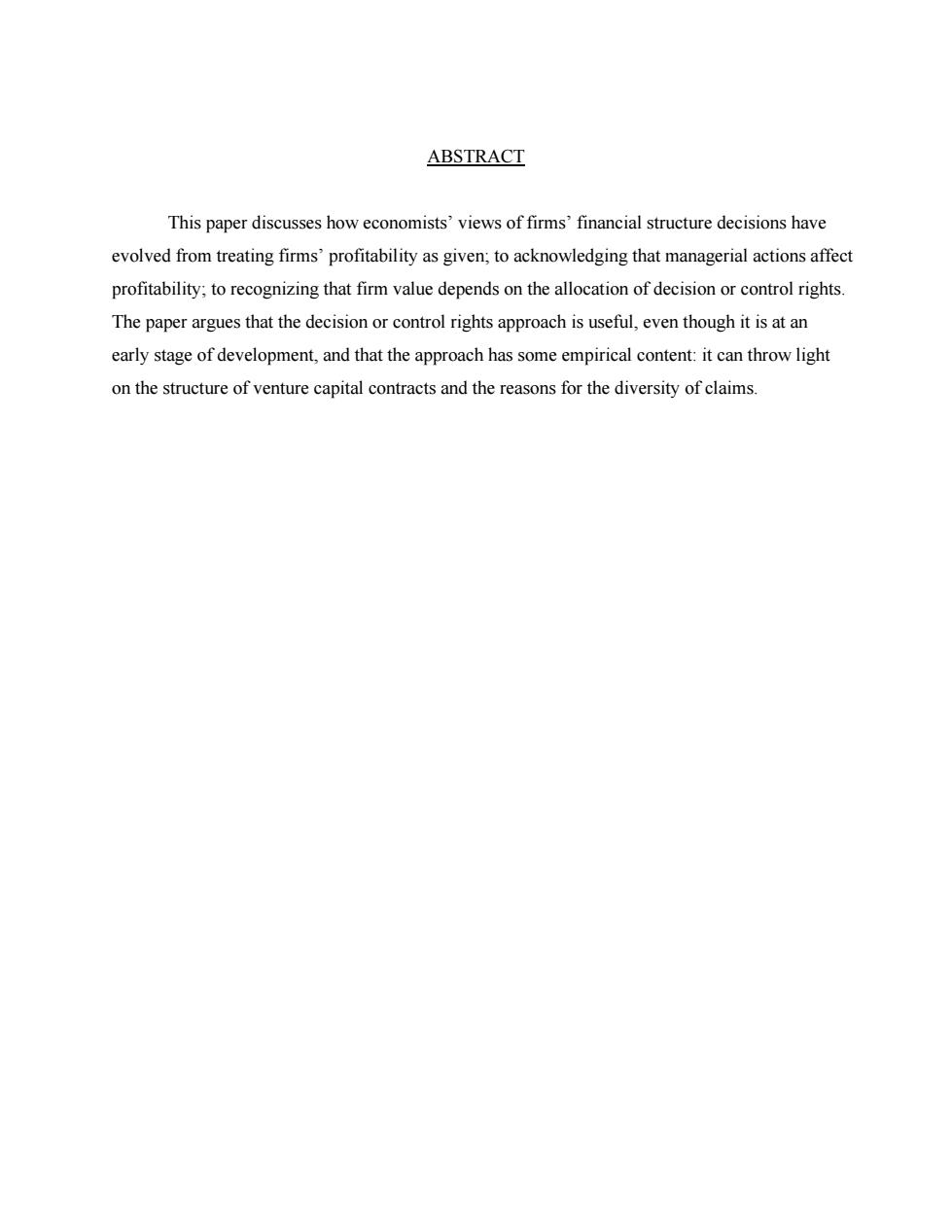
ABSTRACT This paper discusses how economists'views of firms'financial structure decisions have evolved from treating firms'profitability as given;to acknowledging that managerial actions affect profitability;to recognizing that firm value depends on the allocation of decision or control rights. The paper argues that the decision or control rights approach is useful,even though it is at an early stage of development,and that the approach has some empirical content:it can throw light on the structure of venture capital contracts and the reasons for the diversity of claims
ABSTRACT This paper discusses how economists’ views of firms’ financial structure decisions have evolved from treating firms’ profitability as given; to acknowledging that managerial actions affect profitability; to recognizing that firm value depends on the allocation of decision or control rights. The paper argues that the decision or control rights approach is useful, even though it is at an early stage of development, and that the approach has some empirical content: it can throw light on the structure of venture capital contracts and the reasons for the diversity of claims
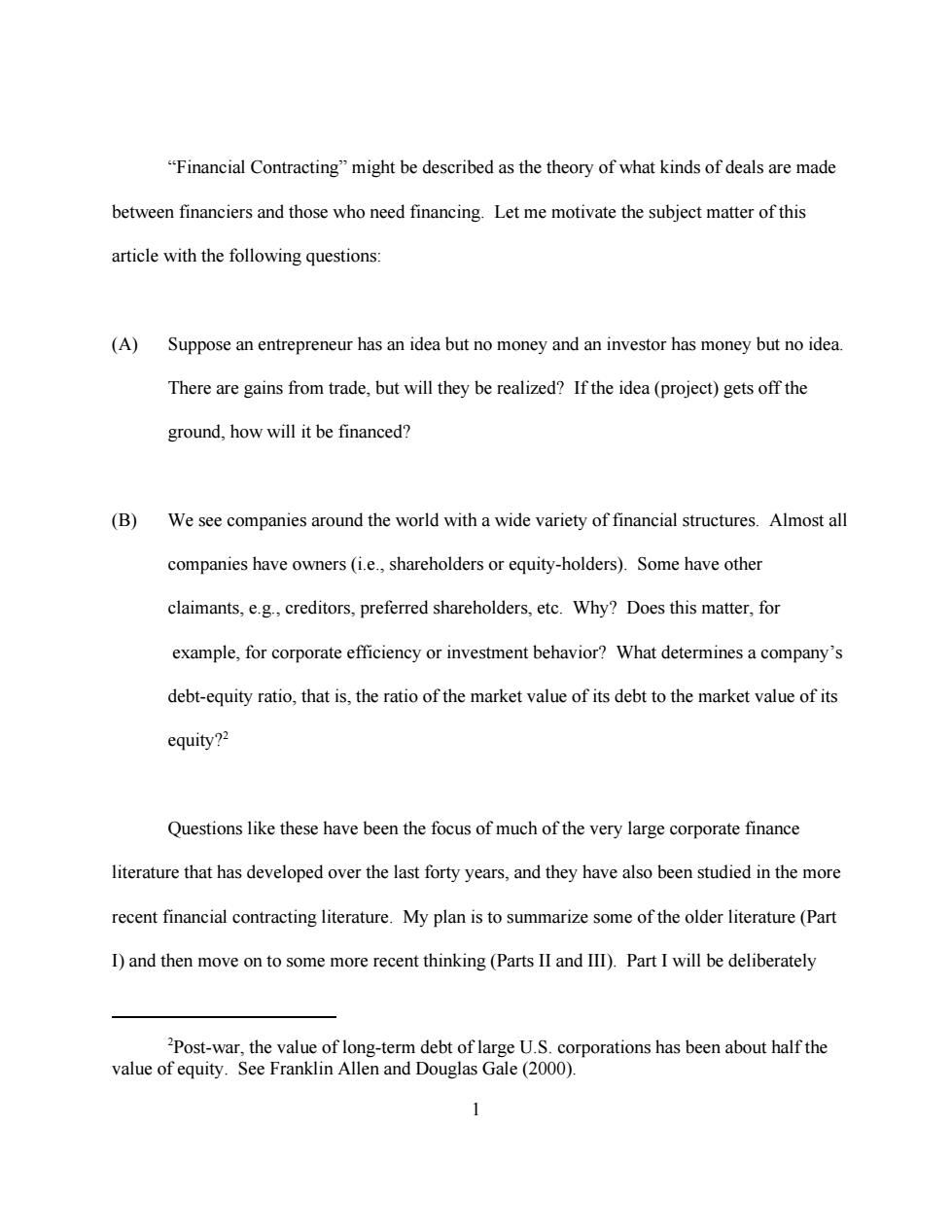
"Financial Contracting"might be described as the theory of what kinds of deals are made between financiers and those who need financing.Let me motivate the subject matter of this article with the following questions: (A) Suppose an entrepreneur has an idea but no money and an investor has money but no idea. There are gains from trade,but will they be realized?If the idea(project)gets off the ground,how will it be financed? (B) We see companies around the world with a wide variety of financial structures.Almost all companies have owners(i.e.,shareholders or equity-holders).Some have other claimants,e.g.,creditors,preferred shareholders,etc.Why?Does this matter,for example,for corporate efficiency or investment behavior?What determines a company's debt-equity ratio,that is,the ratio of the market value of its debt to the market value of its equity?2 Questions like these have been the focus of much of the very large corporate finance literature that has developed over the last forty years,and they have also been studied in the more recent financial contracting literature.My plan is to summarize some of the older literature(Part I)and then move on to some more recent thinking (Parts II and III).Part I will be deliberately 2Post-war,the value of long-term debt of large U.S.corporations has been about half the value of equity.See Franklin Allen and Douglas Gale(2000). 1
2Post-war, the value of long-term debt of large U.S. corporations has been about half the value of equity. See Franklin Allen and Douglas Gale (2000). 1 “Financial Contracting” might be described as the theory of what kinds of deals are made between financiers and those who need financing. Let me motivate the subject matter of this article with the following questions: (A) Suppose an entrepreneur has an idea but no money and an investor has money but no idea. There are gains from trade, but will they be realized? If the idea (project) gets off the ground, how will it be financed? (B) We see companies around the world with a wide variety of financial structures. Almost all companies have owners (i.e., shareholders or equity-holders). Some have other claimants, e.g., creditors, preferred shareholders, etc. Why? Does this matter, for example, for corporate efficiency or investment behavior? What determines a company’s debt-equity ratio, that is, the ratio of the market value of its debt to the market value of its equity? 2 Questions like these have been the focus of much of the very large corporate finance literature that has developed over the last forty years, and they have also been studied in the more recent financial contracting literature. My plan is to summarize some of the older literature (Part I) and then move on to some more recent thinking (Parts II and III). Part I will be deliberately
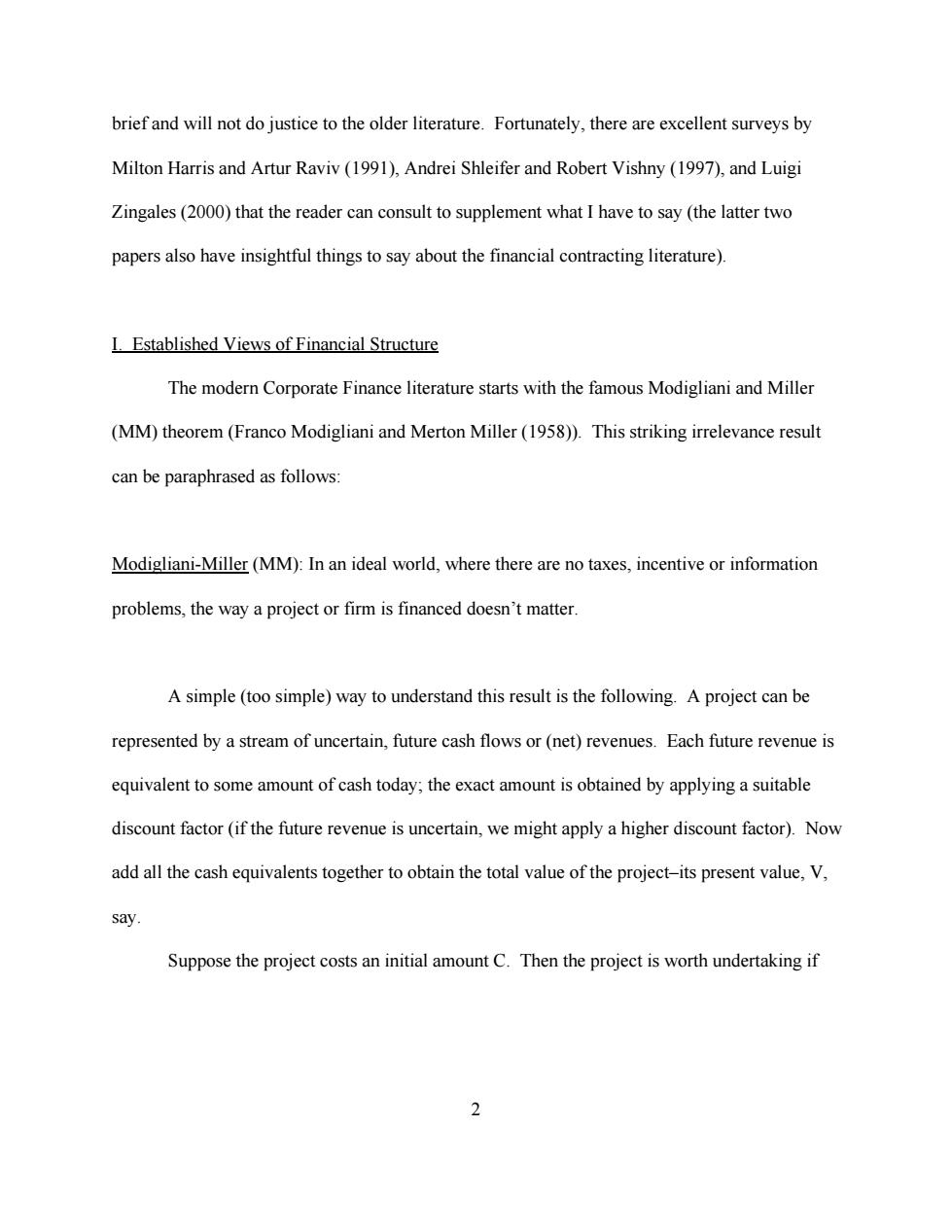
brief and will not do justice to the older literature.Fortunately,there are excellent surveys by Milton Harris and Artur Raviv(1991),Andrei Shleifer and Robert Vishny (1997),and Luigi Zingales(2000)that the reader can consult to supplement what I have to say(the latter two papers also have insightful things to say about the financial contracting literature). I.Established Views of Financial Structure The modern Corporate Finance literature starts with the famous Modigliani and Miller (MM)theorem (Franco Modigliani and Merton Miller(1958)).This striking irrelevance result can be paraphrased as follows: Modigliani-Miller(MM):In an ideal world,where there are no taxes,incentive or information problems,the way a project or firm is financed doesn't matter. A simple (too simple)way to understand this result is the following.A project can be represented by a stream of uncertain,future cash flows or(net)revenues.Each future revenue is equivalent to some amount of cash today;the exact amount is obtained by applying a suitable discount factor(if the future revenue is uncertain,we might apply a higher discount factor).Now add all the cash equivalents together to obtain the total value of the project-its present value,V, say Suppose the project costs an initial amount C.Then the project is worth undertaking if 2
2 brief and will not do justice to the older literature. Fortunately, there are excellent surveys by Milton Harris and Artur Raviv (1991), Andrei Shleifer and Robert Vishny (1997), and Luigi Zingales (2000) that the reader can consult to supplement what I have to say (the latter two papers also have insightful things to say about the financial contracting literature). I. Established Views of Financial Structure The modern Corporate Finance literature starts with the famous Modigliani and Miller (MM) theorem (Franco Modigliani and Merton Miller (1958)). This striking irrelevance result can be paraphrased as follows: Modigliani-Miller (MM): In an ideal world, where there are no taxes, incentive or information problems, the way a project or firm is financed doesn’t matter. A simple (too simple) way to understand this result is the following. A project can be represented by a stream of uncertain, future cash flows or (net) revenues. Each future revenue is equivalent to some amount of cash today; the exact amount is obtained by applying a suitable discount factor (if the future revenue is uncertain, we might apply a higher discount factor). Now add all the cash equivalents together to obtain the total value of the project–its present value, V, say. Suppose the project costs an initial amount C. Then the project is worth undertaking if
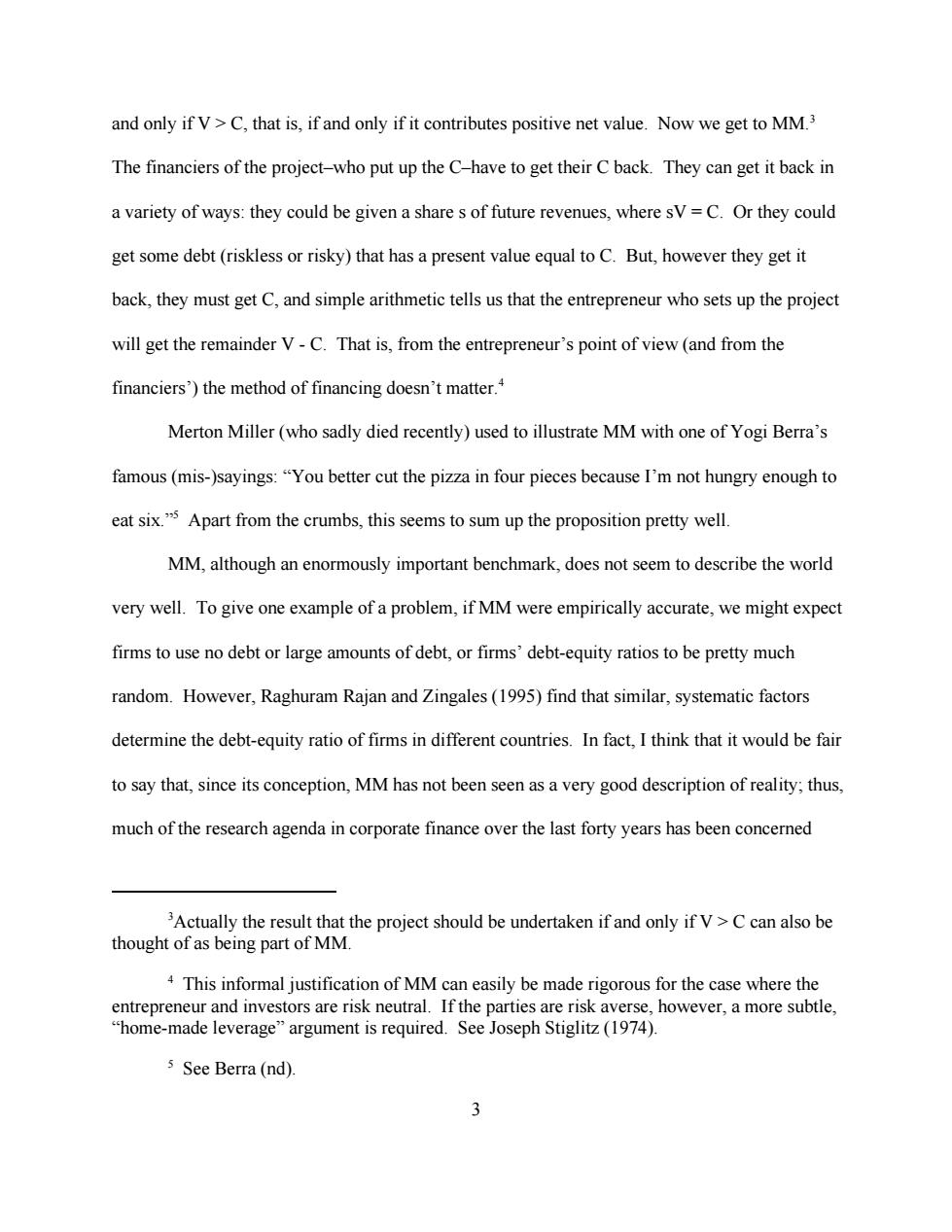
and only if V>C,that is,if and only if it contributes positive net value.Now we get to MM.3 The financiers of the project-who put up the C-have to get their C back.They can get it back in a variety of ways:they could be given a share s of future revenues,where sV=C.Or they could get some debt(riskless or risky)that has a present value equal to C.But,however they get it back,they must get C,and simple arithmetic tells us that the entrepreneur who sets up the project will get the remainder V-C.That is,from the entrepreneur's point of view (and from the financiers')the method of financing doesn't matter. Merton Miller (who sadly died recently)used to illustrate MM with one of Yogi Berra's famous(mis-)sayings:"You better cut the pizza in four pieces because I'm not hungry enough to eat six."5 Apart from the crumbs,this seems to sum up the proposition pretty well. MM,although an enormously important benchmark,does not seem to describe the world very well.To give one example of a problem,if MM were empirically accurate,we might expect firms to use no debt or large amounts of debt,or firms'debt-equity ratios to be pretty much random.However,Raghuram Rajan and Zingales(1995)find that similar,systematic factors determine the debt-equity ratio of firms in different countries.In fact,I think that it would be fair to say that,since its conception,MM has not been seen as a very good description of reality;thus, much of the research agenda in corporate finance over the last forty years has been concerned SActually the result that the project should be undertaken if and only if V>C can also be thought of as being part of MM. 4 This informal justification of MM can easily be made rigorous for the case where the entrepreneur and investors are risk neutral.If the parties are risk averse,however,a more subtle, "home-made leverage"argument is required.See Joseph Stiglitz (1974). 5 See Berra(nd). 3
3Actually the result that the project should be undertaken if and only if V > C can also be thought of as being part of MM. 4 This informal justification of MM can easily be made rigorous for the case where the entrepreneur and investors are risk neutral. If the parties are risk averse, however, a more subtle, “home-made leverage” argument is required. See Joseph Stiglitz (1974). 5 See Berra (nd). 3 and only if V > C, that is, if and only if it contributes positive net value. Now we get to MM. 3 The financiers of the project–who put up the C–have to get their C back. They can get it back in a variety of ways: they could be given a share s of future revenues, where sV = C. Or they could get some debt (riskless or risky) that has a present value equal to C. But, however they get it back, they must get C, and simple arithmetic tells us that the entrepreneur who sets up the project will get the remainder V - C. That is, from the entrepreneur’s point of view (and from the financiers’) the method of financing doesn’t matter. 4 Merton Miller (who sadly died recently) used to illustrate MM with one of Yogi Berra’s famous (mis-)sayings: “You better cut the pizza in four pieces because I’m not hungry enough to eat six.” 5 Apart from the crumbs, this seems to sum up the proposition pretty well. MM, although an enormously important benchmark, does not seem to describe the world very well. To give one example of a problem, if MM were empirically accurate, we might expect firms to use no debt or large amounts of debt, or firms’ debt-equity ratios to be pretty much random. However, Raghuram Rajan and Zingales (1995) find that similar, systematic factors determine the debt-equity ratio of firms in different countries. In fact, I think that it would be fair to say that, since its conception, MM has not been seen as a very good description of reality; thus, much of the research agenda in corporate finance over the last forty years has been concerned
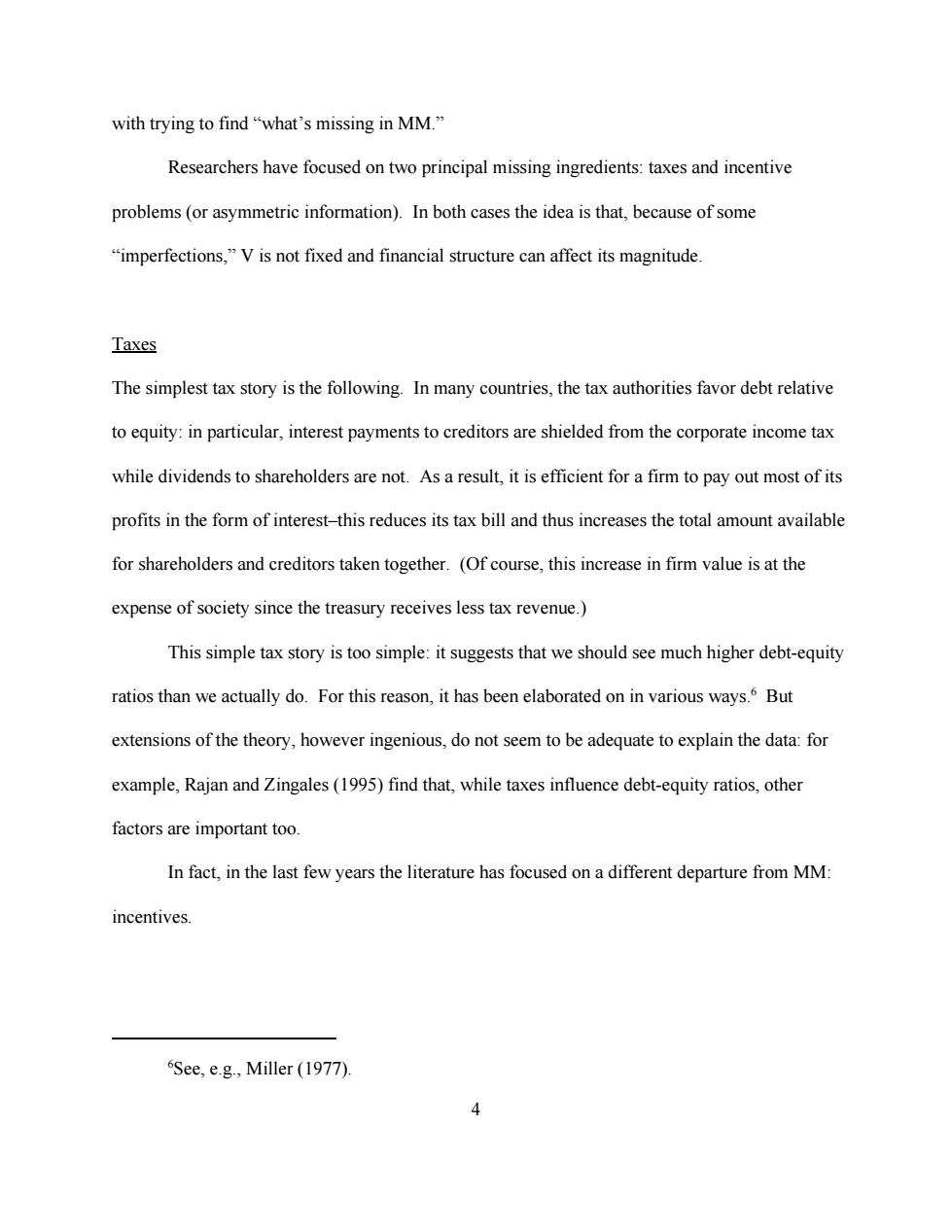
with trying to find“what's missing in MM.” Researchers have focused on two principal missing ingredients:taxes and incentive problems(or asymmetric information).In both cases the idea is that,because of some "imperfections,"V is not fixed and financial structure can affect its magnitude. Taxes The simplest tax story is the following.In many countries,the tax authorities favor debt relative to equity:in particular,interest payments to creditors are shielded from the corporate income tax while dividends to shareholders are not.As a result,it is efficient for a firm to pay out most of its profits in the form of interest-this reduces its tax bill and thus increases the total amount available for shareholders and creditors taken together.(Of course,this increase in firm value is at the expense of society since the treasury receives less tax revenue.) This simple tax story is too simple:it suggests that we should see much higher debt-equity ratios than we actually do.For this reason,it has been elaborated on in various ways.5 But extensions of the theory,however ingenious,do not seem to be adequate to explain the data:for example,Rajan and Zingales(1995)find that,while taxes influence debt-equity ratios,other factors are important too. In fact,in the last few years the literature has focused on a different departure from MM: incentives. See,e.g.,Miller(1977). 4
6See, e.g., Miller (1977). 4 with trying to find “what’s missing in MM.” Researchers have focused on two principal missing ingredients: taxes and incentive problems (or asymmetric information). In both cases the idea is that, because of some “imperfections,” V is not fixed and financial structure can affect its magnitude. Taxes The simplest tax story is the following. In many countries, the tax authorities favor debt relative to equity: in particular, interest payments to creditors are shielded from the corporate income tax while dividends to shareholders are not. As a result, it is efficient for a firm to pay out most of its profits in the form of interest–this reduces its tax bill and thus increases the total amount available for shareholders and creditors taken together. (Of course, this increase in firm value is at the expense of society since the treasury receives less tax revenue.) This simple tax story is too simple: it suggests that we should see much higher debt-equity ratios than we actually do. For this reason, it has been elaborated on in various ways. 6 But extensions of the theory, however ingenious, do not seem to be adequate to explain the data: for example, Rajan and Zingales (1995) find that, while taxes influence debt-equity ratios, other factors are important too. In fact, in the last few years the literature has focused on a different departure from MM: incentives
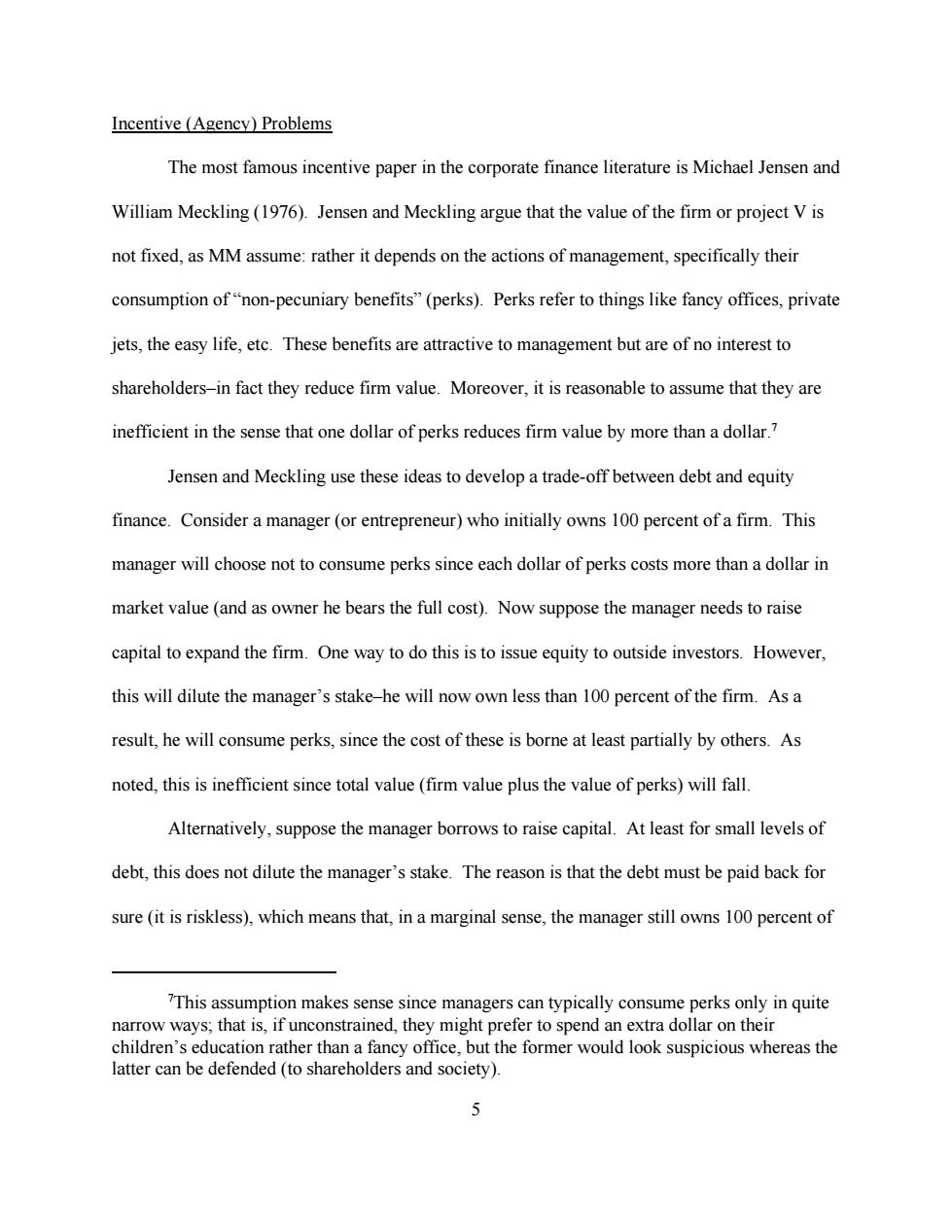
Incentive (Agency)Problems The most famous incentive paper in the corporate finance literature is Michael Jensen and William Meckling (1976).Jensen and Meckling argue that the value of the firm or project V is not fixed,as MM assume:rather it depends on the actions of management,specifically their consumption of"non-pecuniary benefits"(perks).Perks refer to things like fancy offices,private jets,the easy life,etc.These benefits are attractive to management but are of no interest to shareholders-in fact they reduce firm value.Moreover,it is reasonable to assume that they are inefficient in the sense that one dollar of perks reduces firm value by more than a dollar.? Jensen and Meckling use these ideas to develop a trade-off between debt and equity finance.Consider a manager(or entrepreneur)who initially owns 100 percent of a firm.This manager will choose not to consume perks since each dollar of perks costs more than a dollar in market value(and as owner he bears the full cost).Now suppose the manager needs to raise capital to expand the firm.One way to do this is to issue equity to outside investors.However, this will dilute the manager's stake-he will now own less than 100 percent of the firm.As a result,he will consume perks,since the cost of these is borne at least partially by others.As noted,this is inefficient since total value(firm value plus the value of perks)will fall. Alternatively,suppose the manager borrows to raise capital.At least for small levels of debt,this does not dilute the manager's stake.The reason is that the debt must be paid back for sure (it is riskless),which means that,in a marginal sense,the manager still owns 100 percent of 7This assumption makes sense since managers can typically consume perks only in quite narrow ways;that is,if unconstrained,they might prefer to spend an extra dollar on their children's education rather than a fancy office,but the former would look suspicious whereas the latter can be defended (to shareholders and society). 5
7This assumption makes sense since managers can typically consume perks only in quite narrow ways; that is, if unconstrained, they might prefer to spend an extra dollar on their children’s education rather than a fancy office, but the former would look suspicious whereas the latter can be defended (to shareholders and society). 5 Incentive (Agency) Problems The most famous incentive paper in the corporate finance literature is Michael Jensen and William Meckling (1976). Jensen and Meckling argue that the value of the firm or project V is not fixed, as MM assume: rather it depends on the actions of management, specifically their consumption of “non-pecuniary benefits” (perks). Perks refer to things like fancy offices, private jets, the easy life, etc. These benefits are attractive to management but are of no interest to shareholders–in fact they reduce firm value. Moreover, it is reasonable to assume that they are inefficient in the sense that one dollar of perks reduces firm value by more than a dollar. 7 Jensen and Meckling use these ideas to develop a trade-off between debt and equity finance. Consider a manager (or entrepreneur) who initially owns 100 percent of a firm. This manager will choose not to consume perks since each dollar of perks costs more than a dollar in market value (and as owner he bears the full cost). Now suppose the manager needs to raise capital to expand the firm. One way to do this is to issue equity to outside investors. However, this will dilute the manager’s stake–he will now own less than 100 percent of the firm. As a result, he will consume perks, since the cost of these is borne at least partially by others. As noted, this is inefficient since total value (firm value plus the value of perks) will fall. Alternatively, suppose the manager borrows to raise capital. At least for small levels of debt, this does not dilute the manager’s stake. The reason is that the debt must be paid back for sure (it is riskless), which means that, in a marginal sense, the manager still owns 100 percent of
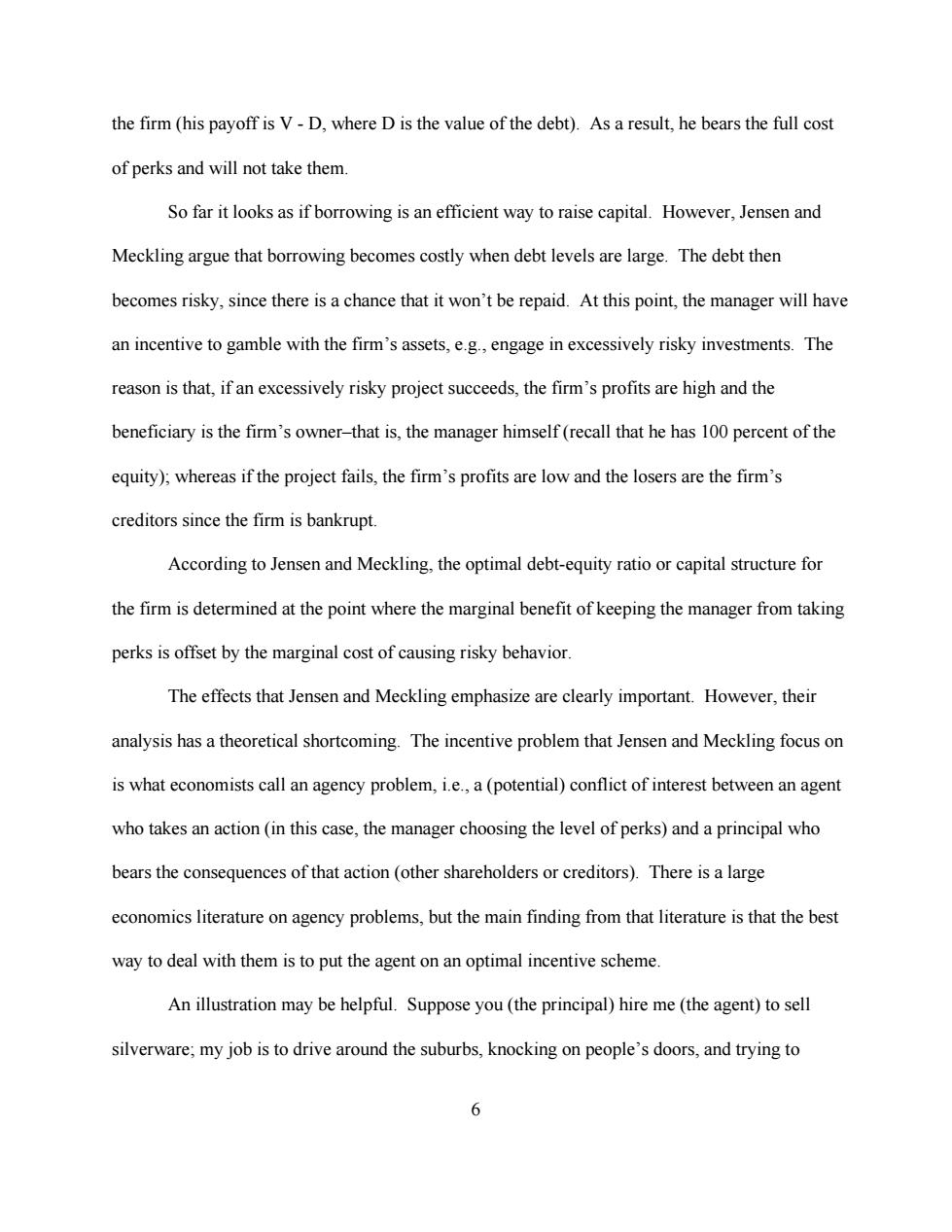
the firm (his payoff is V-D,where D is the value of the debt).As a result,he bears the full cost of perks and will not take them. So far it looks as if borrowing is an efficient way to raise capital.However,Jensen and Meckling argue that borrowing becomes costly when debt levels are large.The debt then becomes risky,since there is a chance that it won't be repaid.At this point,the manager will have an incentive to gamble with the firm's assets,e.g.,engage in excessively risky investments.The reason is that,if an excessively risky project succeeds,the firm's profits are high and the beneficiary is the firm's owner-that is,the manager himself(recall that he has 100 percent of the equity);whereas if the project fails,the firm's profits are low and the losers are the firm's creditors since the firm is bankrupt. According to Jensen and Meckling,the optimal debt-equity ratio or capital structure for the firm is determined at the point where the marginal benefit of keeping the manager from taking perks is offset by the marginal cost of causing risky behavior. The effects that Jensen and Meckling emphasize are clearly important.However,their analysis has a theoretical shortcoming.The incentive problem that Jensen and Meckling focus on is what economists call an agency problem,i.e.,a(potential)conflict of interest between an agent who takes an action (in this case,the manager choosing the level of perks)and a principal who bears the consequences of that action (other shareholders or creditors).There is a large economics literature on agency problems,but the main finding from that literature is that the best way to deal with them is to put the agent on an optimal incentive scheme. An illustration may be helpful.Suppose you(the principal)hire me (the agent)to sell silverware;my job is to drive around the suburbs,knocking on people's doors,and trying to 6
6 the firm (his payoff is V - D, where D is the value of the debt). As a result, he bears the full cost of perks and will not take them. So far it looks as if borrowing is an efficient way to raise capital. However, Jensen and Meckling argue that borrowing becomes costly when debt levels are large. The debt then becomes risky, since there is a chance that it won’t be repaid. At this point, the manager will have an incentive to gamble with the firm’s assets, e.g., engage in excessively risky investments. The reason is that, if an excessively risky project succeeds, the firm’s profits are high and the beneficiary is the firm’s owner–that is, the manager himself (recall that he has 100 percent of the equity); whereas if the project fails, the firm’s profits are low and the losers are the firm’s creditors since the firm is bankrupt. According to Jensen and Meckling, the optimal debt-equity ratio or capital structure for the firm is determined at the point where the marginal benefit of keeping the manager from taking perks is offset by the marginal cost of causing risky behavior. The effects that Jensen and Meckling emphasize are clearly important. However, their analysis has a theoretical shortcoming. The incentive problem that Jensen and Meckling focus on is what economists call an agency problem, i.e., a (potential) conflict of interest between an agent who takes an action (in this case, the manager choosing the level of perks) and a principal who bears the consequences of that action (other shareholders or creditors). There is a large economics literature on agency problems, but the main finding from that literature is that the best way to deal with them is to put the agent on an optimal incentive scheme. An illustration may be helpful. Suppose you (the principal) hire me (the agent) to sell silverware; my job is to drive around the suburbs, knocking on people’s doors, and trying to
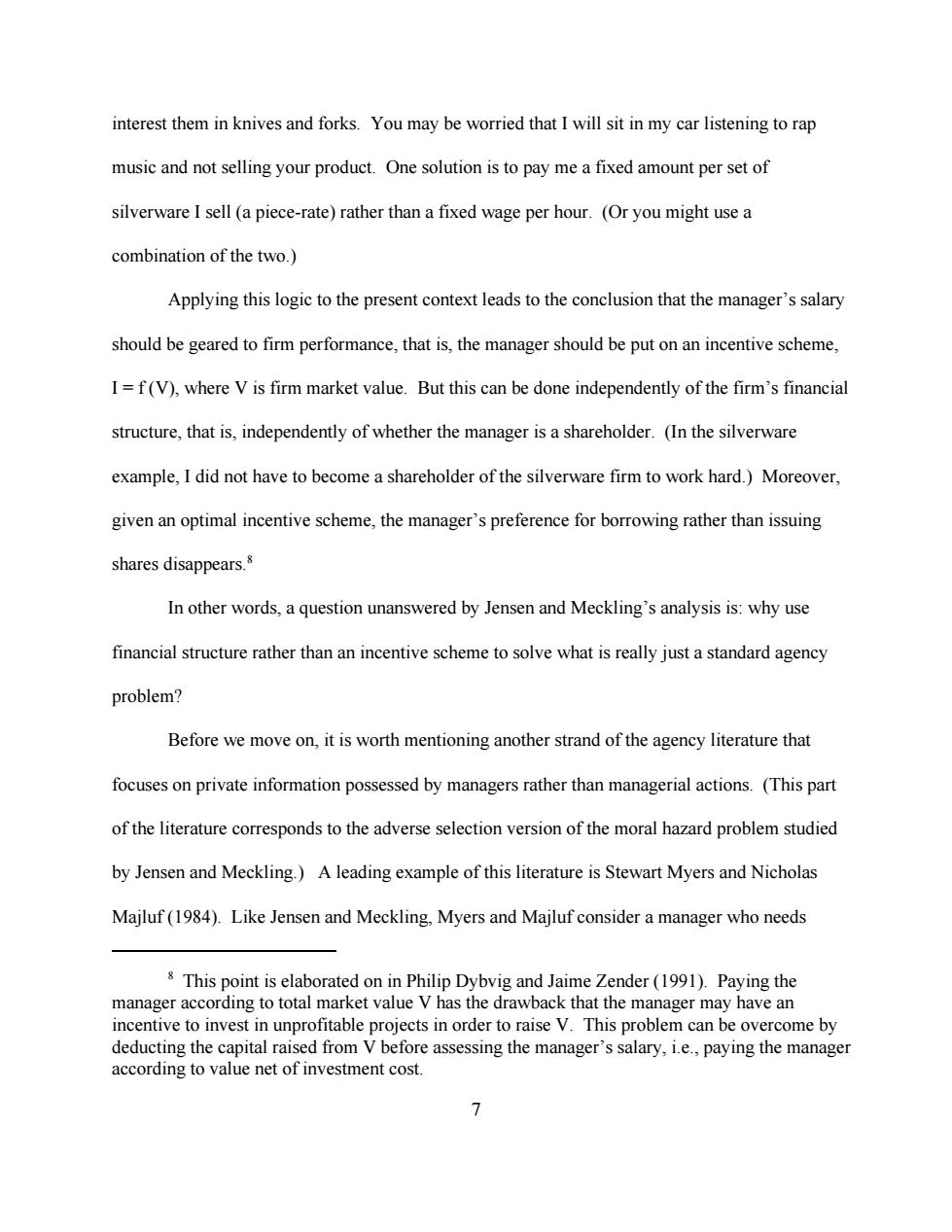
interest them in knives and forks.You may be worried that I will sit in my car listening to rap music and not selling your product.One solution is to pay me a fixed amount per set of silverware I sell (a piece-rate)rather than a fixed wage per hour.(Or you might use a combination of the two.) Applying this logic to the present context leads to the conclusion that the manager's salary should be geared to firm performance,that is,the manager should be put on an incentive scheme, I=f(V),where V is firm market value.But this can be done independently of the firm's financial structure,that is,independently of whether the manager is a shareholder.(In the silverware example,I did not have to become a shareholder of the silverware firm to work hard.)Moreover, given an optimal incentive scheme,the manager's preference for borrowing rather than issuing shares disappears.8 In other words,a question unanswered by Jensen and Meckling's analysis is:why use financial structure rather than an incentive scheme to solve what is really just a standard agency problem? Before we move on,it is worth mentioning another strand of the agency literature that focuses on private information possessed by managers rather than managerial actions.(This part of the literature corresponds to the adverse selection version of the moral hazard problem studied by Jensen and Meckling.)A leading example of this literature is Stewart Myers and Nicholas Majluf(1984).Like Jensen and Meckling,Myers and Majluf consider a manager who needs s This point is elaborated on in Philip Dybvig and Jaime Zender(1991).Paying the manager according to total market value V has the drawback that the manager may have an incentive to invest in unprofitable projects in order to raise V.This problem can be overcome by deducting the capital raised from V before assessing the manager's salary,i.e.,paying the manager according to value net of investment cost. 7
8 This point is elaborated on in Philip Dybvig and Jaime Zender (1991). Paying the manager according to total market value V has the drawback that the manager may have an incentive to invest in unprofitable projects in order to raise V. This problem can be overcome by deducting the capital raised from V before assessing the manager’s salary, i.e., paying the manager according to value net of investment cost. 7 interest them in knives and forks. You may be worried that I will sit in my car listening to rap music and not selling your product. One solution is to pay me a fixed amount per set of silverware I sell (a piece-rate) rather than a fixed wage per hour. (Or you might use a combination of the two.) Applying this logic to the present context leads to the conclusion that the manager’s salary should be geared to firm performance, that is, the manager should be put on an incentive scheme, I = f (V), where V is firm market value. But this can be done independently of the firm’s financial structure, that is, independently of whether the manager is a shareholder. (In the silverware example, I did not have to become a shareholder of the silverware firm to work hard.) Moreover, given an optimal incentive scheme, the manager’s preference for borrowing rather than issuing shares disappears. 8 In other words, a question unanswered by Jensen and Meckling’s analysis is: why use financial structure rather than an incentive scheme to solve what is really just a standard agency problem? Before we move on, it is worth mentioning another strand of the agency literature that focuses on private information possessed by managers rather than managerial actions. (This part of the literature corresponds to the adverse selection version of the moral hazard problem studied by Jensen and Meckling.) A leading example of this literature is Stewart Myers and Nicholas Majluf (1984). Like Jensen and Meckling, Myers and Majluf consider a manager who needs